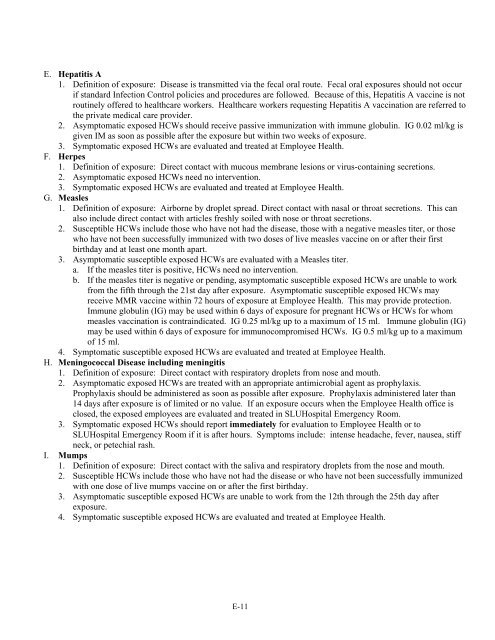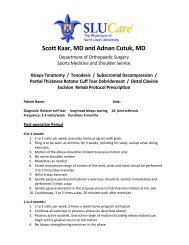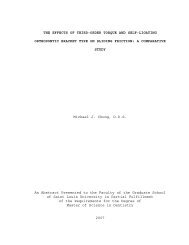Program Manual - Saint Louis University
Program Manual - Saint Louis University
Program Manual - Saint Louis University
You also want an ePaper? Increase the reach of your titles
YUMPU automatically turns print PDFs into web optimized ePapers that Google loves.
E. Hepatitis A<br />
1. Definition of exposure: Disease is transmitted via the fecal oral route. Fecal oral exposures should not occur<br />
if standard Infection Control policies and procedures are followed. Because of this, Hepatitis A vaccine is not<br />
routinely offered to healthcare workers. Healthcare workers requesting Hepatitis A vaccination are referred to<br />
the private medical care provider.<br />
2. Asymptomatic exposed HCWs should receive passive immunization with immune globulin. IG 0.02 ml/kg is<br />
given IM as soon as possible after the exposure but within two weeks of exposure.<br />
3. Symptomatic exposed HCWs are evaluated and treated at Employee Health.<br />
F. Herpes<br />
1. Definition of exposure: Direct contact with mucous membrane lesions or virus-containing secretions.<br />
2. Asymptomatic exposed HCWs need no intervention.<br />
3. Symptomatic exposed HCWs are evaluated and treated at Employee Health.<br />
G. Measles<br />
1. Definition of exposure: Airborne by droplet spread. Direct contact with nasal or throat secretions. This can<br />
also include direct contact with articles freshly soiled with nose or throat secretions.<br />
2. Susceptible HCWs include those who have not had the disease, those with a negative measles titer, or those<br />
who have not been successfully immunized with two doses of live measles vaccine on or after their first<br />
birthday and at least one month apart.<br />
3. Asymptomatic susceptible exposed HCWs are evaluated with a Measles titer.<br />
a. If the measles titer is positive, HCWs need no intervention.<br />
b. If the measles titer is negative or pending, asymptomatic susceptible exposed HCWs are unable to work<br />
from the fifth through the 21st day after exposure. Asymptomatic susceptible exposed HCWs may<br />
receive MMR vaccine within 72 hours of exposure at Employee Health. This may provide protection.<br />
Immune globulin (IG) may be used within 6 days of exposure for pregnant HCWs or HCWs for whom<br />
measles vaccination is contraindicated. IG 0.25 ml/kg up to a maximum of 15 ml. Immune globulin (IG)<br />
may be used within 6 days of exposure for immunocompromised HCWs. IG 0.5 ml/kg up to a maximum<br />
of 15 ml.<br />
4. Symptomatic susceptible exposed HCWs are evaluated and treated at Employee Health.<br />
H. Meningococcal Disease including meningitis<br />
1. Definition of exposure: Direct contact with respiratory droplets from nose and mouth.<br />
2. Asymptomatic exposed HCWs are treated with an appropriate antimicrobial agent as prophylaxis.<br />
Prophylaxis should be administered as soon as possible after exposure. Prophylaxis administered later than<br />
14 days after exposure is of limited or no value. If an exposure occurs when the Employee Health office is<br />
closed, the exposed employees are evaluated and treated in SLUHospital Emergency Room.<br />
3. Symptomatic exposed HCWs should report immediately for evaluation to Employee Health or to<br />
SLUHospital Emergency Room if it is after hours. Symptoms include: intense headache, fever, nausea, stiff<br />
neck, or petechial rash.<br />
I. Mumps<br />
1. Definition of exposure: Direct contact with the saliva and respiratory droplets from the nose and mouth.<br />
2. Susceptible HCWs include those who have not had the disease or who have not been successfully immunized<br />
with one dose of live mumps vaccine on or after the first birthday.<br />
3. Asymptomatic susceptible exposed HCWs are unable to work from the 12th through the 25th day after<br />
exposure.<br />
4. Symptomatic susceptible exposed HCWs are evaluated and treated at Employee Health.<br />
E-11

















